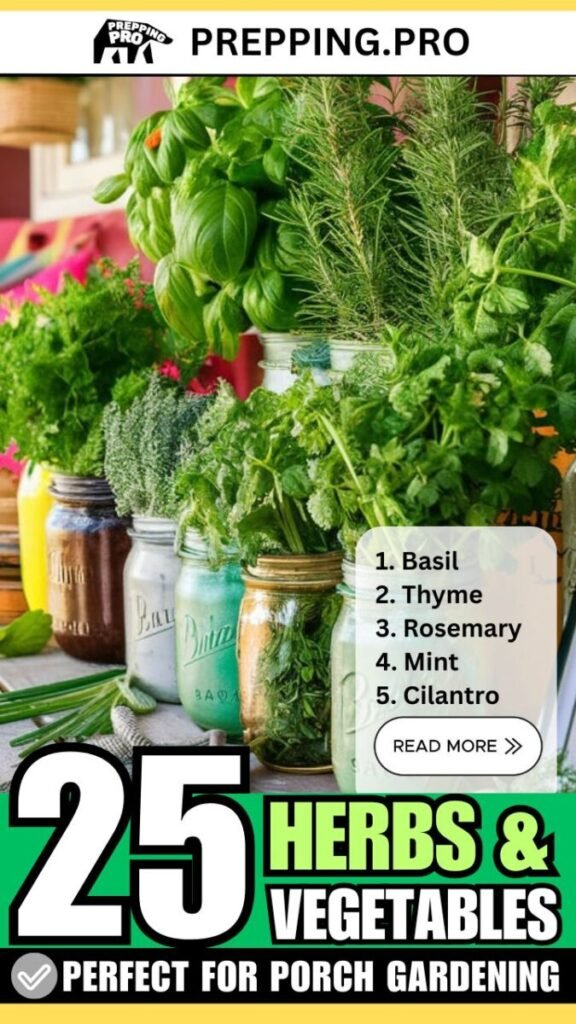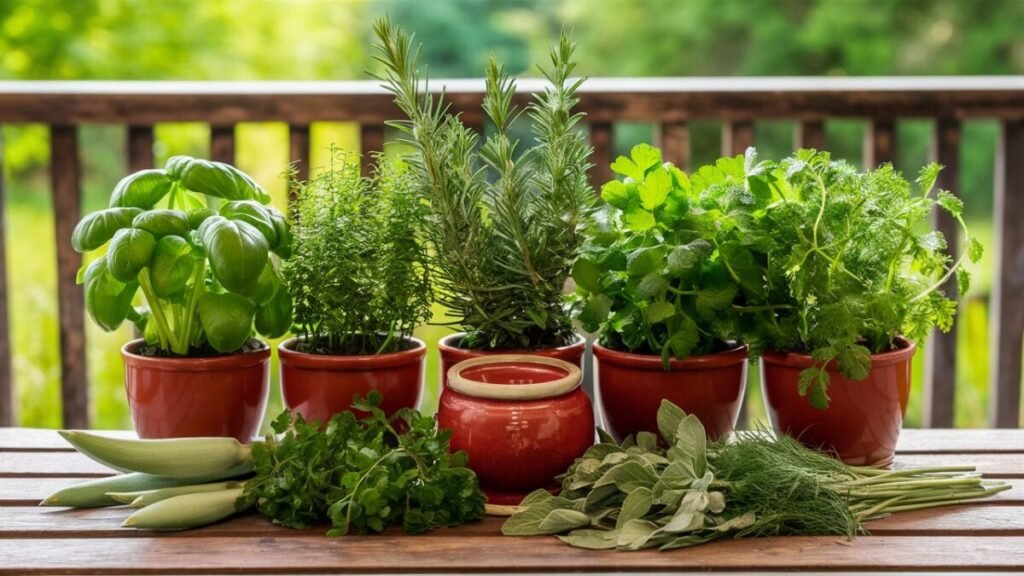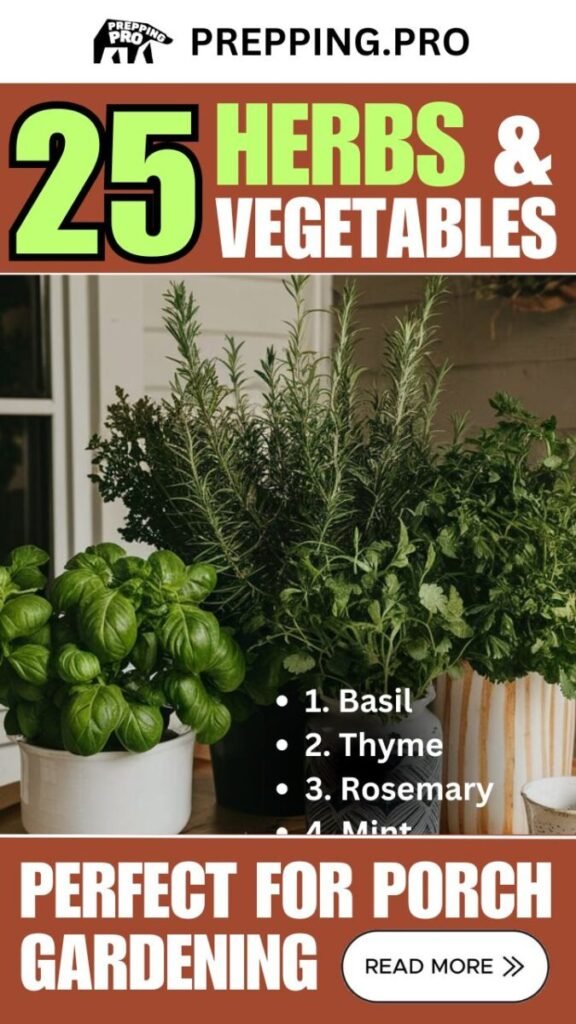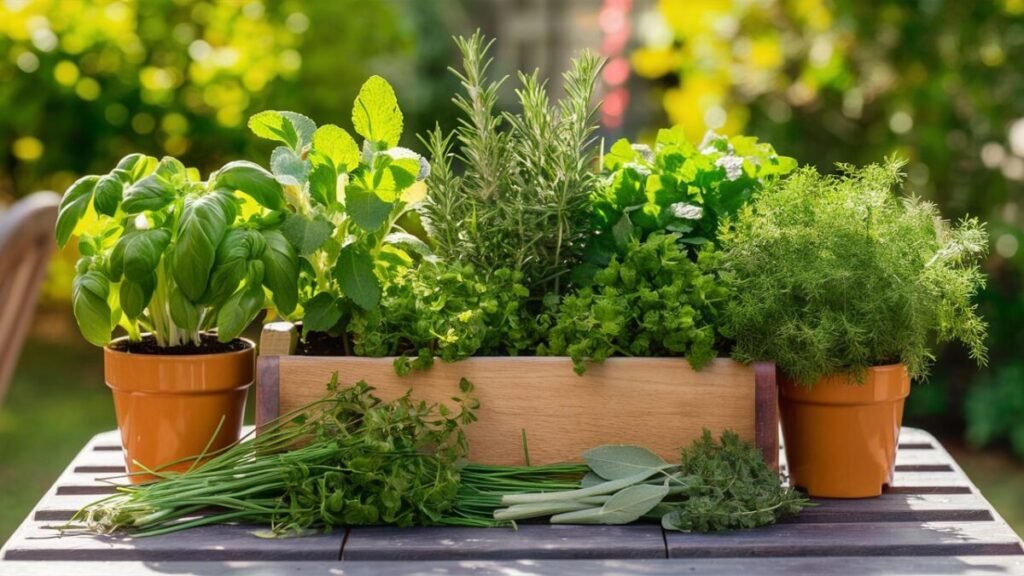Table of Contents
Introduction
Are you a prepper looking to maximize your food security in limited spaces?
Herbs and vegetables for porch gardening offer an excellent solution for urban survivalists and small-space dwellers alike.
In this comprehensive guide, we’ll explore 25 essential plants that thrive in container gardens, providing you with a sustainable source of fresh, organic produce right outside your door.

By mastering the art of porch gardening for preppers, you’ll learn how to cultivate a diverse range of herbs and vegetables in compact containers, maximizing your yield and enhancing your self-sufficiency.
From space-saving techniques to preservation methods, this article covers everything you need to know to create a thriving survival garden on your porch or balcony.
Key Takeaways:
- Discover 25 herbs and vegetables ideal for porch gardening
- Learn space-saving techniques for maximizing your yield
- Explore organic gardening methods for healthier produce
- Master preservation techniques to extend your harvest
- Troubleshoot common issues in small-space gardening
Here’s a quick overview of the top 25 herbs and vegetables for your porch garden:
| Herbs | Leafy Greens | Vegetables |
|---|---|---|
| Basil, Thyme, Rosemary, Mint, Cilantro, Parsley, Chives, Oregano, Sage, Dill | Lettuce, Spinach, Kale, Swiss Chard, Arugula | Cherry Tomatoes, Peppers, Radishes, Carrots, Green Onions, Bush Beans, Peas, Compact Zucchini, Dwarf Eggplants, Microgreens |
1. Essential Herbs for Your Porch Garden

Herb gardens provide a wealth of flavors and medicinal benefits in a compact space. These ten herbs thrive in containers and offer versatility for cooking and survival purposes.
- Choose herbs based on your culinary preferences and medicinal needs
- Plant herbs in separate containers to prevent overgrowth
- Harvest herbs regularly to promote bushy growth and prevent flowering
| Herb | Sun Requirements | Water Needs | Container Size |
|---|---|---|---|
| Basil | Full sun | Moderate | 6-8 inches deep |
| Thyme | Full sun | Low | 4-6 inches deep |
| Rosemary | Full sun | Low | 12 inches deep |
| Mint | Partial shade | Moderate | 8-10 inches deep |
| Cilantro | Partial shade | Moderate | 6-8 inches deep |
| Parsley | Partial shade | Moderate | 8-10 inches deep |
| Chives | Full sun | Moderate | 6 inches deep |
| Oregano | Full sun | Low | 6 inches deep |
| Sage | Full sun | Low | 8-10 inches deep |
| Dill | Full sun | Moderate | 8-10 inches deep |
2. Leafy Greens for Small-Space Gardening
Leafy greens provide essential nutrients and grow quickly in confined spaces. These five varieties offer a continuous harvest and adapt well to container gardening.
- Plant leafy greens in succession for a constant supply
- Harvest outer leaves to promote continued growth
- Use shallow, wide containers to maximize space efficiency
| Leafy Green | Days to Maturity | Container Depth | Spacing |
|---|---|---|---|
| Lettuce | 30-60 days | 6 inches | 4-6 inches apart |
| Spinach | 40-50 days | 6-8 inches | 3-4 inches apart |
| Kale | 50-65 days | 8-10 inches | 12 inches apart |
| Swiss Chard | 50-60 days | 8-10 inches | 6 inches apart |
| Arugula | 30-40 days | 4-6 inches | 2-3 inches apart |
3. Compact Vegetables for Container Gardening
Patio vegetables offer high yields in small spaces. These five compact varieties thrive in containers and provide essential nutrients for your survival diet.
- Choose dwarf or determinate varieties for container cultivation
- Provide adequate support for vining plants
- Monitor soil moisture closely, as containers dry out faster than ground soil
| Vegetable | Container Size | Sun Requirements | Watering Needs |
|---|---|---|---|
| Cherry Tomatoes | 5-gallon | Full sun | Regular |
| Peppers | 3-gallon | Full sun | Moderate |
| Radishes | 6 inches deep | Full sun to partial shade | Regular |
| Carrots | 12 inches deep | Full sun | Regular |
| Green Onions | 6 inches deep | Full sun to partial shade | Moderate |
4. Climbing Vegetables for Vertical Gardening
Vertical gardening maximizes space utilization in small areas. These two climbing vegetables provide protein-rich options for your porch garden.
- Install trellises or supports for climbing plants
- Train vines regularly to ensure proper growth
- Harvest frequently to encourage continued production
| Vegetable | Trellis Height | Container Size | Days to Maturity |
|---|---|---|---|
| Bush Beans | 2-3 feet | 5-gallon | 50-60 days |
| Peas | 4-6 feet | 8-10 inches deep | 60-70 days |

5. Space-Saving Squash and Eggplants
Compact varieties of squash and eggplants offer substantial yields in limited spaces. These two vegetables add variety to your porch garden and survival menu.
- Choose bush or dwarf varieties specifically bred for containers
- Provide sturdy support for fruit-bearing branches
- Prune excess foliage to improve air circulation and prevent disease
| Vegetable | Container Size | Spacing | Days to Maturity |
|---|---|---|---|
| Compact Zucchini | 5-gallon | 1 plant per container | 45-55 days |
| Dwarf Eggplants | 5-gallon | 1 plant per container | 60-70 days |
6. Microgreens: Nutrient-Packed Powerhouses
Microgreens offer a quick and nutrient-dense crop for survival situations. These young seedlings provide intense flavors and high nutritional value in a small space.
- Grow microgreens in shallow trays or recycled containers
- Harvest within 1-3 weeks of planting for optimal nutrition
- Rotate crops frequently for a continuous supply
| Microgreen Variety | Days to Harvest | Flavor Profile | Nutrient Highlights |
|---|---|---|---|
| Radish | 5-10 days | Spicy | Vitamin C, Potassium |
| Broccoli | 7-14 days | Mild, cabbage-like | Sulforaphane, Vitamin K |
| Sunflower | 7-14 days | Nutty, crunchy | Protein, Vitamin E |
| Pea Shoots | 10-14 days | Sweet, pea-like | Vitamin A, Folate |
7. Edible Landscaping with Herbs and Vegetables
Edible landscaping combines aesthetics with functionality in your porch garden. This approach maximizes space utilization while creating an attractive outdoor area.
- Integrate herbs and vegetables with ornamental plants
- Use vertical elements like trellises and hanging baskets
- Incorporate plants with varying heights and textures for visual interest
| Plant | Function | Aesthetic Value |
|---|---|---|
| Swiss Chard | Edible leaves | Colorful stems |
| Nasturtiums | Edible flowers and leaves | Bright blooms |
| Lemon Thyme | Culinary herb | Fragrant groundcover |
| Dwarf Blueberries | Edible fruit | Seasonal foliage color |
8. Organic Gardening Techniques for Porch Gardens
Organic gardening practices ensure the safety and quality of your produce. These techniques promote soil health and natural pest control in your porch garden.
- Use compost and organic fertilizers to nourish plants
- Implement companion planting for natural pest management
- Practice crop rotation to maintain soil fertility
| Organic Technique | Purpose | Implementation |
|---|---|---|
| Composting | Soil enrichment | Create a small compost bin for kitchen scraps |
| Companion Planting | Pest control | Plant basil near tomatoes to repel pests |
| Mulching | Moisture retention | Apply organic mulch around plants |
| Neem Oil Spray | Natural pesticide | Mix neem oil with water and spray on affected plants |
9. Harvesting and Preserving Your Porch Garden Bounty
Proper harvesting and preservation techniques extend the usefulness of your porch garden produce. These methods ensure a steady supply of food for survival situations.
- Harvest vegetables and herbs at their peak for best flavor and nutrition
- Use various preservation methods to extend shelf life
- Store preserved foods in a cool, dark place for maximum longevity
| Preservation Method | Best For | Storage Life |
|---|---|---|
| Drying | Herbs, hot peppers | 6-12 months |
| Freezing | Leafy greens, peas, beans | 6-12 months |
| Canning | Tomatoes, pickled vegetables | 12-18 months |
| Fermentation | Cabbage, radishes | 2-6 months |
10. Troubleshooting Common Porch Gardening Issues
Porch gardeners often face unique challenges. These solutions address common problems encountered in small-space gardening.
- Monitor plants regularly for signs of stress or disease
- Adjust watering and fertilization based on plant needs
- Implement preventative measures to avoid common issues
| Issue | Cause | Solution |
|---|---|---|
| Leggy Plants | Insufficient light | Use grow lights or relocate to sunnier spot |
| Root Rot | Overwatering | Improve drainage, reduce watering frequency |
| Nutrient Deficiency | Poor soil quality | Supplement with organic fertilizers |
| Pest Infestation | Lack of biodiversity | Introduce beneficial insects, use organic pest control |
Conclusion

Porch gardening provides an effective solution for preppers seeking to enhance their food security in urban or limited-space environments.
The 25 herbs and vegetables outlined in this article offer a diverse range of options for creating a productive and sustainable porch garden.
By implementing these strategies and techniques, you can establish a thriving source of fresh, organic produce right outside your door.
Start small, experiment with different plants, and gradually expand your porch garden to build self-reliance and ensure a consistent food supply for survival situations.
For more advanced techniques, consider exploring winter gardening methods to extend your growing season year-round.


